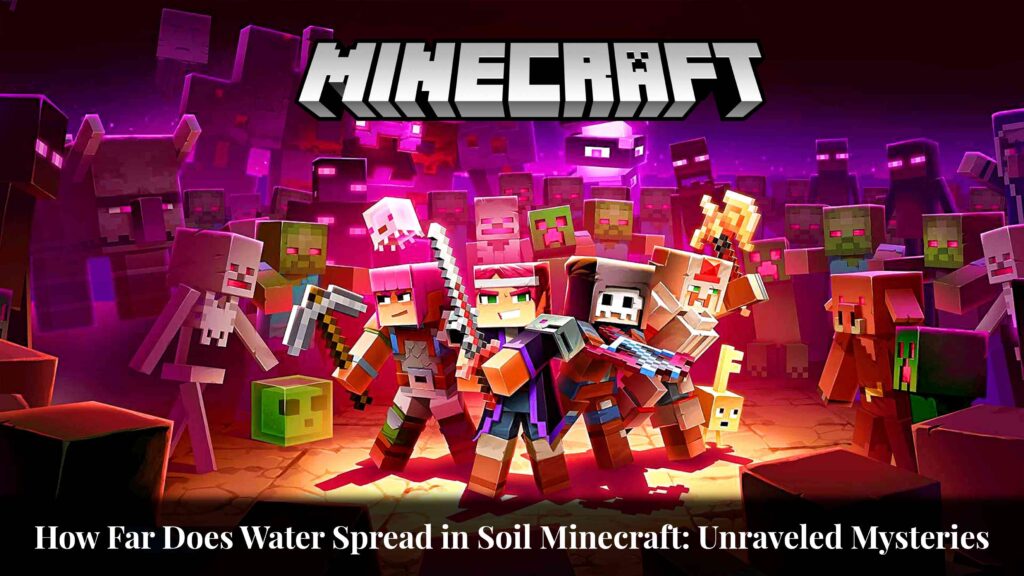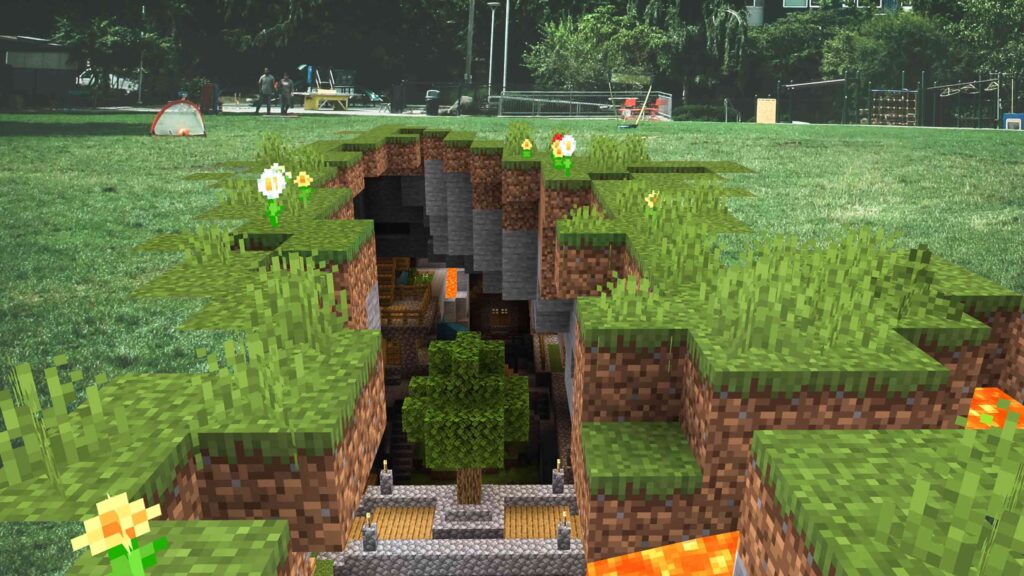Ah, Minecraft. It’s not just a game, but an art of farming, crafting, and surviving. One aspect many requests revolve around is water in soil. How far does it spread? How does it affect your farm? Let’s dive into these mysteries.
Basics of Minecraft Water Mechanics
Every player knows that water is crucial. In the Java edition and Bedrock edition, water operates uniquely. It flows, fills blocks, and interacts with different sources. But how does it function with soil? That’s what we’ll uncover.
How Far Does Water Spread Horizontally in Soil Minecraft?
One of the most common questions about how far does water spread in soil Minecraft is how far does water spread horizontally in soil Minecraft. Horizontal spread refers to the distance that water can travel along the same level or height from a source block. Horizontal spread is important for farming purposes because it determines how much land you can irrigate with one source block.
The answer to how far does water spread horizontally in soil Minecraft depends on the shape and direction of the surface that the water is flowing on. There are three main shapes of surfaces that water can flow on: flat, sloped, and curved. There are also four main directions that water can flow on: north, south, east, and west.
How Water Hydrates Soil: The Science
It’s fascinating! When water comes into contact with a dirt block, it changes. It turns that dirt into hydrated farmland. The moisture level rises, which is crucial for crops. They thrive on hydrated soil, growing at an enhanced rate.
Minecraft simplifies real-world science but keeps the essence intact. When a water source block is placed near dirt, it magically converts the dirt into hydrated farmland. This isn’t mere aesthetics. Hydrated farmland provides a vital boost to crop growth rates, ensuring players reap bountiful harvests.
The game has a specific hydration radius: a water source hydrates soil up to four blocks away. This means, for effective farming, players need to strategically place water every few blocks. Such placement ensures that every dirt block gets its share of moisture, imitating the real-world concept of optimal irrigation.
For Minecraft enthusiasts, this isn’t just a game mechanic, but a reflection of the real-life importance of water in agriculture. While the blocky universe simplifies the process, the core principle remains – water is pivotal for thriving crops, both in virtual farmlands and our backyards.
The Spread Range of Water in Soil
Water can stretch out and downwards. This downward current is key for farms with multiple levels. Keep in mind the four-block rule. It defines how farmland benefits from a water source.
In the digital realm of Minecraft, the spread range of water in soil has implications far beyond just aesthetics; it’s the backbone of efficient farming. But how does water spread in this blocky universe?
In Minecraft, the mechanics are streamlined. When a water source block is introduced, it hydrates adjacent dirt blocks, transforming them into farmland. The catch? The effective hydration radius is precisely four blocks. This means that, for optimal growth, crops should be planted within this four-block radius from the water source. Any farther, and the crops miss out on the hydration benefits, affecting their growth rates.
Moreover, the water doesn’t just move horizontally; it flows and can be directed using channels or barriers. The strategic placement of water source blocks, therefore, becomes essential for players who want to maximize their farming output.
This mechanic in Minecraft captures the essence of real-world irrigation, simplified for gameplay. It underscores the importance of understanding the land-water relationship, even in a virtual setting. As any seasoned Minecraft player will affirm, mastering the spread range of water in soil can make the difference between a thriving farm and a mediocre one.
Irrigation Techniques for Optimal Soil Hydration
Successful farming in Minecraft hinges on understanding its unique irrigation techniques. Let’s delve into optimizing soil hydration for thriving crops in the game.
- Strategic Placement: In Minecraft, a water source block hydrates adjacent soil up to a four-block radius. By placing water source blocks at regular intervals, you can ensure that your entire farmland remains hydrated, propelling crop growth.
- Trench Irrigation: Create trenches filled with water in between rows of crops. This not only maximizes hydration but also allows easy navigation through your farm without trampling crops.
- Elevated Water Source: Construct elevated water channels. By placing water at a higher block, you ensure it flows downward, covering more ground and maximizing hydration.
Advanced Water Channeling Techniques
Water behaves in many ways. It flows in directions, can be channeled using solid block designs, and even flows downwards. Master these techniques, and your farm’s efficiency skyrockets.
Effects of Rain on Soil Hydration
Rain brings a blessing. It hydrates farmland. But is it equivalent to a water source block? No. Rain helps, but temporary. Direct water sources offer consistency.
The Benefits of Proper Water Management in Minecraft Farms
Minecraft is a game that allows you to create and explore infinite worlds, build amazing structures, and play with other players. It is also a game that allows you to farm and grow crops, such as wheat, carrots, potatoes, and more. Farming is a useful and rewarding activity in Minecraft, as it provides you with food, resources, and experience.
However, farming is not as simple as planting seeds and harvesting crops. You also need to manage your water supply and distribution, as water is essential for crop growth and survival. Water hydrates the soil and prevents it from drying out or decaying. Water also affects the growth rate and yield of your crops.
Proper water management in Minecraft farms can bring you many benefits, such as:
• Faster and higher crop production: By keeping your soil hydrated and moist, you can speed up the growth process and increase the harvest amount of your crops. You can also avoid wasting seeds or losing crops due to dehydration or decay.
• More efficient and convenient farming: By optimizing your water spread and range, you can save space and time for your farming. You can also reduce the risk of trampling or destroying your crops by walking or jumping on them.
• More creative and aesthetic farming: By controlling your water flow and direction, you can create different designs and layouts for your farming. You can also enhance the appearance and atmosphere of your farming area with water features.
Common Mistakes in Watering Minecraft Farms
Watering in Minecraft farms might seem straightforward, but many players inadvertently make errors that hamper their crop yields. Here are some common mistakes to avoid for successful farming:
- Overextension: One of the most frequent oversights is forgetting the four-block hydration radius rule. Planting crops beyond this range from a water source means they won’t get adequately hydrated, leading to stunted growth.
- Inadequate Watering: Some players sporadically place water source blocks, thinking occasional hydration is enough. However, consistent access to water is vital for crops to thrive.
- Over-Reliance on Rain: While rainwater does hydrate soil in Minecraft, solely depending on it is risky. Rain is unpredictable, and certain biomes rarely experience rainfall.
Tools and Items to Aid in Soil Hydration
The bucket. It’s essential. It helps players transport water blocks with ease. Automated systems use them, ensuring a farm’s moisture remains optimal.
The Environmental Impact of Water Spread
In Minecraft, a game known for its blocky landscapes and imaginative play, water is more than just a visual treat. It serves functional roles and, when not managed correctly, has environmental implications.
- Land Alteration: Water can drastically change the landscape. Misplaced water source blocks can lead to erosion, converting soil into dirt or washing away sand, thereby reshaping terrains unexpectedly.
- Ecosystem Disruption: Water can drown out flora, like grass or flowers, if it’s not properly contained. This can alter the spawning of specific mobs and change the natural habitat of an area.
- Cave Flooding: Accidental water flow into underground caverns can disrupt mining activities and endanger the player by creating hazardous water currents or by pushing hostile mobs toward the player.
Automated Farming Systems and Soil Hydration
Modern farms use automation. Redstone mechanics combined with water sources can create efficient farming designs. The key is ensuring every soil block remains hydrated.
Challenges in Water Management
In the pixelated world of Minecraft, water isn’t just a visual treat; it’s a tool, a challenge, and sometimes, a menace. Managing it effectively is a game within the game, and here are some challenges players face:
- Unpredictable Flow: Unlike the real world, water in Minecraft has its own set of physics. It can flow up to seven blocks on a flat surface but can also spread indefinitely if there are no blocks to stop its path. Predicting this flow, especially in uneven terrains, can be tricky.
- Inadvertent Flooding: Misplacing a single water source block or breaking the wrong block near a water body can lead to unexpected flooding, potentially ruining nearby structures or redstone mechanisms.
- Underwater Building: Constructing underwater is a dream for many players, but water can seep into every nook, making it a challenging endeavor. Clearing water and ensuring structures remain water-free is a task.
- Irrigation Precision: With a hydration radius of only four blocks for farmland, ensuring every crop gets the water it needs without wasting space requires planning.
- Aquatic Mobs: Water isn’t just about the liquid. Dealing with aquatic mobs like drowned or guardians when working in or near water adds an element of danger.
How to Control How Far Does Water Spread in Soil Minecraft for Building Purposes
Water behavior in Minecraft, while simplified compared to the real world, requires understanding and manipulation, especially when building. Here’s how to control water spread in soil for your architectural ventures:
- Understand the Basics: First, grasp the fundamentals. Water travels up to seven blocks from a source block on a flat surface. But for soil hydration, the radius is four blocks. This knowledge sets the foundation for your water-based builds.
- Utilize Slabs and Stairs: These can serve as partial barriers. When water encounters a slab or stair, it treats it as a full block, stopping its flow. They’re great for creating controlled water features without completely blocking the view.
- Channels and Trenches: Digging channels or trenches helps guide water in your desired direction. By manipulating the ground level, you dictate the water’s path.
- Use Doors and Fence Gates: Both doors and fence gates can block water, but when opened, they allow entities to pass through without letting water flow freely. This trick is perfect for underwater builds.
- Sponges: A sponge block can absorb water in a 7-block radius, making it invaluable for clearing out areas. Wet sponges can be dried in a furnace and reused.
Learning from Real-life Agriculture
Minecraft mimics reality. Understanding real-world farming can improve your in-game activities. For instance, crop rotation or irrigation can be adapted for better game farms.
Conclusion
Congratulations! You’ve now gained a deeper understanding of how water spreads in soil within the vast world of Minecraft. From learning about water source block mechanics and hydration extent to exploring optimal crop placement patterns, you’re equipped with valuable knowledge to enhance your farming skills. As you dive into the postgeneration and natural generation of water, you’ll uncover fascinating insights into the history and data history of water mechanics in Minecraft.
But wait, there’s more! Don’t forget to compare Bedrock Edition and Java Edition to discover the differences in water mechanics. Understanding these distinctions will enable you to make informed decisions. Now that you possess this newfound knowledge, it’s time to put it into action and revolutionize your Minecraft farming experience. So grab your virtual shovel, embrace the power of water, and watch as your crops flourish like never before!
Frequently Asked Questions (FAQs)
- Q: Can crops grow without water in Minecraft?
- A: Yes, but slower. Water boosts growth rates.
- Q: Is there a way to increase the 4-block hydration radius?
- A: In vanilla Minecraft, no. But mods might help.
- Q: How does water from rain compare with water from buckets?
- A: Rain helps but is temporary. Buckets offer a steady source.









